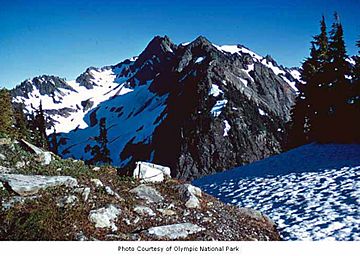Mount La Crosse facts for kids
Quick facts for kids Mount La Crosse |
|
|---|---|
 |
|
| Highest point | |
| Elevation | 6,417 ft (1,956 m) |
| Prominence | 977 ft (298 m) |
| Geography | |
| Location | Jefferson County, Washington, United States |
| Parent range | Olympic Mountains |
| Topo map | USGS Mount Steel |
| Geology | |
| Age of rock | Eocene |
| Type of rock | Basalt |
| Climbing | |
| First ascent | 1928 Richard Paulson, William Ryer, Paul Wiseman, Frank Woodworth |
| Easiest route | Scrambling Class 2 |
Mount La Crosse is a tall mountain peak in the Olympic Mountains of Washington state. It stands about 6,417 feet (1,956 meters) high. You can find it in Jefferson County.
This mountain is part of the beautiful Olympic National Park. Its closest taller neighbor is Mount Elk Lick, which is about 2.29 miles (3.69 km) to the east. The large Anderson massif is about 2.67 miles (4.30 km) north of Mount La Crosse. Also, White Mountain is nearby, about 0.95 miles (1.53 km) to the southwest.
Mountain's Name and First Climb
The name "Mount La Crosse" comes from a nearby body of water called Lake La Crosse. Back in 1890, explorers on the O'Neil Expedition gave the lake a special name: "Lake of the Holy Cross." They chose this name because a large tree with branches shaped like a cross stood guard over the lake.
Over time, the name changed. First, it became "Lake of the Cross," and then finally, "Lake La Crosse." Sometimes, you might even see the mountain's name spelled as Mount LaCrosse.
The very first time people successfully climbed to the top of Mount La Crosse was in 1928. The climbers were Richard Paulson, William Ryer, Paul Wiseman, and Frank Woodworth.
Weather Around Mount La Crosse
Mount La Crosse is in a place with a "marine west coast" climate. This means it gets a lot of weather from the Pacific Ocean. Most of the weather systems, like clouds and rain, start over the Pacific and move towards the Olympic Mountains.
When these weather systems hit the tall Olympic peaks, they are forced to rise. As the air goes higher, it cools down and drops its moisture. This causes a lot of rain or snow, especially in winter. This process is called orographic lift. Because of this, the Olympic Mountains get a lot of precipitation.
In winter, the weather is often cloudy. But in summer, high-pressure systems over the Pacific Ocean usually bring clear skies. The best time to climb Mount La Crosse is usually from June to September, when the weather is nicer. Water from the mountain flows into streams that feed the Dosewallips River and Duckabush River.
Images for kids




